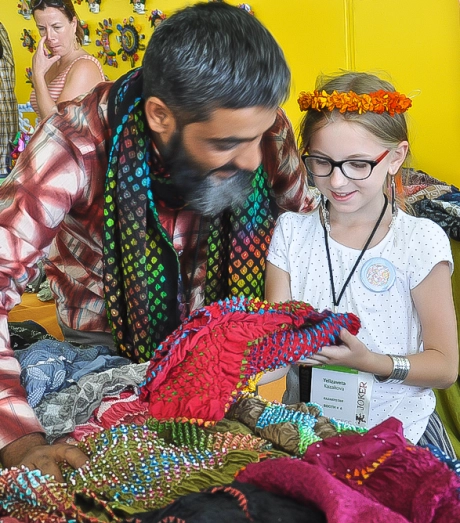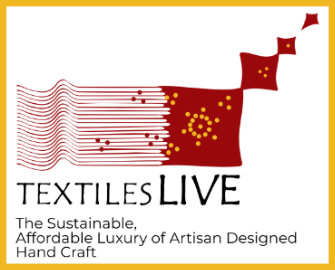Valuing the Unique: Re-Thinking Scale
a talk given at the Indian Institute of Management Ahmedabad, for
“Crafting Luxury and Lifestyle Businesses.” February 2016
 Two important marks of luxury are customization and hand-work.
Two important marks of luxury are customization and hand-work.
Paradoxically, craft is often valued as inexpensive. How do we bridge this gap so that the artisan benefits, so that we can insure that quality hand work will continue?
What is the most ethical way to engage artisans in luxury work?
When I originally made this presentation, it was as a keynote address for the International Textile and Apparel Association. At that time, I was asked to consider the role of textile artisan work in the fast emerging “creative economy.” I had to think on that. Traditional craft in the contemporary world is an evolving relationship. Society evolves, the market evolves– at an ever faster pace. Artisans try to keep up their own evolution, with integrity. There is an inherent challenge, however, because craft is NOT fast. The stage at which we have arrived, which is just that: considering traditional craft in the context of the creative economy, is the most challenging yet. I do not yet have solutions, but I am working on defining the points we have to address…
To me, the key point is Value. While we celebrate the unique, how do we insure that we also value it?
There is a range of craft practiced today, from traditional to professional/ commercial. I am focusing on traditional crafts, those that are an integral part of culture, and express identity and cultural heritage, and those that are designed as well as made by the artisan. I believe that we need to address traditional craft to keep genuinely valuable hand work not only alive but evolving.
We know there is a market for good, tradition-based craft, (which is also called “folk art.”)
In India, we are blessed with a robust urban domestic market. In addition, a growing number of artisans from India, and all over the world, have had the opportunity to attend The International Folk Art Market| Santa Fe, now considered the apex of the traditional craft market.
The IFAM |SF has been growing since 2004. Here are some statistics for 2015:
173 folk artists from 57 countries
19,000 visitors
$2.9 million of folk art sold in 21 hours
Average booth sales over $20,000
This is some good evidence that there is a market- and value- for craft with excellent design, production and market readiness.
But the Santa Fe Folk Art Market’s reach is limited. What percentage of world artisans would 173 be? And a number of these artisans are returnees who have come to depend on the market for a comfortable livelihood.
If we want to celebrate the unique, how can the other thousands of artisans all over the world find a market to value their work so that they can increase their income to an equitable and sustainable level? Because in many places, when artisans cannot earn equitably, they simply leave craft.
How are artisans going to market?
We can we learn a lot from the International Folk Art Market.
It celebrates- and values the unique. The event has been voted #1 art festival in the USA and a top 20 must-see event globally! Buyers fly in from all over the country and the world to experience this event, when surely they could buy craft closer to home.
One key to its success is the personal, joyful connection between maker and user– the original essence of traditional craft.
But, where to go from here? One thing I hear continually is “scaling up craft production.”
Funding agencies overtly or covertly make this a prerequisite for fundable projects. Sometimes scaling up is mentioned in the same breath as lauding the personal aspects of craft! I keenly question the fit of “large scale” and “Folk Art.”
Is this simply an assumption based on an industrial-oriented society?
Who is asking for scale in craft?
Do Artisans want scale? Traditionally, craft was never done in big scale. In fact, in Kutch it was a part-time occupation, practiced in lulls of the agricultural cycle. The consumers, traditionally, were well known and production was close to customized.
My concern is that scaling up will extinguish the essence of hand made craft. If craft is mass-produced, what is the meaning of hand work? Did we not invent machines to do just this: mass produce?
The next question is, how much do artisans need to produce to be economically viable?
I asked the three SKV artisans who participated in the IFAM| Santa Fe in July 2015 their views on scale. Interestingly, they represent three levels of scale:
Junaid, a block printer does large-scale work. He said, “There is demand for scale, and an advantage, but it requires standardization, accurate costing, and a good capital base. We have both scale and quality, but we have problems with colour variation. So we work with customers who accept this.
Abdulaziz, a bandhani artist, has increased his scale to mid-range. He said, “With increase in scale, there is a compromise in quality. We need and want to increase scale. But the question is, how to do it and keep the quality?”
Dahyalal, a small scale family production weaver, said, “I don’t believe in large scale for craft. It is then not craft.”
Scaling up is the industrial model, with the goals of faster, cheaper, and more standard production. For craft and artisans, growth must engage the vital aspects of traditional art:
- First, folk art is hand made. It is the creation of the human hand guided by the human spirit.
- Folk art is slow, labour intensive,
- Folk art limited in production- or one of a kind, and full of quirky character.
- Folk art has meaning. It is the expression of cultural heritage and identity.
- Traditionally, folk art is crafted of natural materials, with ecologically sound practices.
- Folk art is produced in rural, remote regions of the world.
If artisans are not interested in scale, is it craft consumers who want scale?
Most often, the customer for craft is not interested in mass production; that is why s/he is buying craft. An informative study of craft markets done by the Craft Council of England in 2010 elaborates on what craft consumers want.[1] First, in England craft consumption is significant. 63% of the population consumes £913m/ of craft a year.
Craft consumers tend to be women, educated, older, culturally active, open and independent thinking. More important, the study defines cultural consumption and it correlates craft buying choices to current consumer trends.
English consumers value craft in terms of authenticity, quality, workmanship, and personal touch. In a time termed the Era of Consequences, consumer demand has shifted towards value-centered products that meet emotional as well as functional needs. People buy craft as a unique and also ethical route for consuming objects. They consider craft buying as an experience, and a new way of signaling connoisseurship. In short, scaling up hand craft production will not likely meet the needs of these consumers.
The study I am citing was Euro-centric, where there is a sense of “creative economy,” and hand craft is relatively rare and perceived as valuable. In applying its findings to traditional craft in developing countries there are some significant differences. In India, for example, craft is not so rare. There are large numbers of traditional artisans (as well as others who have acquired craft skills).
 Foremost in this scenario is the core issue of value, which becomes aggravated with scaling up craft. In the social hierarchy of India, working with one’s hands is equated with low social status. In order to create a greater supply of lower value craft, Master Artisans, those who are economically stronger, employ other artisans as job workers at the lowest possible wages. This further reinforces the perception that the artisan is a laborer. Thus the artisan as well as the craft is de-valued.
Foremost in this scenario is the core issue of value, which becomes aggravated with scaling up craft. In the social hierarchy of India, working with one’s hands is equated with low social status. In order to create a greater supply of lower value craft, Master Artisans, those who are economically stronger, employ other artisans as job workers at the lowest possible wages. This further reinforces the perception that the artisan is a laborer. Thus the artisan as well as the craft is de-valued.
India is not yet conscious of a creative economy. Although- as in the West- machines have taken over the work of the essential, craft continues to be considered in terms of productivity. Government policies view craft as languishing, an inferior type of production, and subsidize handloom artisans to produce plain white cotton-polyester sheets for the Indian Railways, and yardage for children’s school uniforms. Higher value products such as saris and scarves are woven by power looms.
Clearly, the essential characteristics of craft that are valued by consumers in England are not yet well recognized!
In addition, because artisans are perceived as anonymous workers- hands without heads. many good artisans aspire to not working but supervising others- the Peter Principle.
But, the cultural consumption market is not primarily price conscious. So, thinking from the needs of both artisans and consumers, can we think of enhancing value rather than volume? This would mean better wages and better quality of life for more people- horizontal expansion
Genuine enhancing of value for craft begins with perceptions of artisan and craft, from the perspectives of artisan, society and consumer. Thinking on this, and beginning with self worth of the artisan, I launched design education for traditional artisans of Kutch, which I have run for a decade. Design is recognized as valuable– til now, more valuable than craft. It was in directing the program, that I realized that a key result of the education was to encourage the unique. In 135 graduates, we had clear success in individuals emerging in better markets– and no duplication.
After operating the design course for 8 years, I realized that to reap full economic benefit, a bit of business was also needed. So in 2014, I started a course in Business and Management for Artisans. The key learning from this course was the importance of ownership, which dramatically increased capacity, and the value of artisan and craft.
Both courses end in public events. Fashion shows compel the public to value craft and artisans in other ways. Student- planned and implemented exhibitions in prestigious venues in Mumbai provide immediate confirmation of increased value.
Design and entrepreneurship tap individual creativity and unquestionably generate higher value, as well as diversity. Diversity has in turn expanded the market. Artisan designers have increased their income from 10 to 600% and enjoyed new opportunities. Significantly, when asked when they felt their craft was most valued, several artisans responded, “When we are teaching.”
Education for artisans has increased the value of the unique among artisans in one region of a developing country. From this microcosm, we zoom out to the original question: where are artisans with increased capacity going to market their work? Or, perhaps this can be re-worded: how are artisans going to tap that craft market that we have begun to define?
I would like to think of creating a model from the original situation- scaling out, rather than up. This would look like small-scale artisan designer entrepreneurs creating one of a kind or limited edition, highly valued craft. The amount of work produced would be about the same- maybe more! But diversity, de-centralization, ownership, and value would be increased, and benefit would be widely shared.
To build such artisan enterprise, we need to develop an appropriate market.
Arjo Klamer, Priyatej Kotipalli, and others at Erasmus University write of nurturing a Creative Craft Culture.[2] In such a culture, crafts would encompass what we are achieving through education for artisans:
-Young people viewing the creative crafts as a career worth striving for
-Strong traditions of apprenticeship
-A strong sense of tradition,
-Recognition of the masters; fair and effective
-A strong sense of collegiality among creative craftspeople
-A spirit of creativity and innovativeness
-A strong appreciation of entrepreneurship
– Core values and a clear sense of mission (promoting and sustaining quality, contributing to a joyful and inspiring life)
Equally critical for this culture are:
-people who know the world of creative crafts
-appreciation of creative quality
-willingness to pay
-Significant local demand as well as international interest-
So, what Artisans- and craft consumers need is a network of venues in congruence with unique work. Imagine a marketing organization that comprises small, unique venues across the country…. Or the world.
The point of developing local demand is an important one. It will insure broad sustainability. To raise the value of craft to that of design, Marketing is essential.
Consumer trends indicate directions –targeting consumers of luxury goods who are looking to signal connoisseurship in new ways, and people with ethical or ecological motivations.
Do we dare to market traditional craft as valuable for its creativity, authenticity, and uniqueness, and as luxurious for its limited edition, bespoke quality?
The final, critical third component in developing a Creative Craft Culture is:
strong intermediaries- in addition to special shops, experts, journalists, scholarship, and intensive discussions of the works of creative crafts people.
Success is first determined by experts, then by others who pay attention and are able and willing to pay the price. As a wonderful example, three Somaiya Kala Vidya artisan designers- Dahyalal Kudecha, Abdulaziz A. Khatri, and Khalid Amin Khatri- were included in the contemporary design section of a major exhibition at the V&A Museum in UK, Fabric of India. Not only that, but it has been noticed and discussed!
We all can play a part in building a Creative Crafts Culture, insuring that unique craft traditions are not just celebrated but also valued, and insuring that artisans benefit equitably in the process.
[1] McIntyre, Morris Haargreaves, Consuming Craft: the Contemporary Craft Market in a Changing Economy. London: Crafts Council of England, 2010.
[2] Klamer, Arjo, Priyatej Kotipalli, Lili Jiang, Dr. Anna Mignosa, Prof.
Dr. Kazuko Goto, and Thora Fjeldsted , “Crafting Culture: The importance of craftsmanship for the world of the arts and the economy at large.” Erasmus University, June, 2012.



